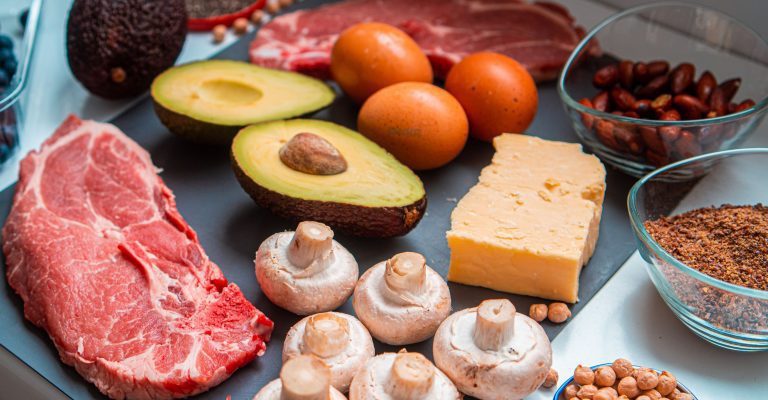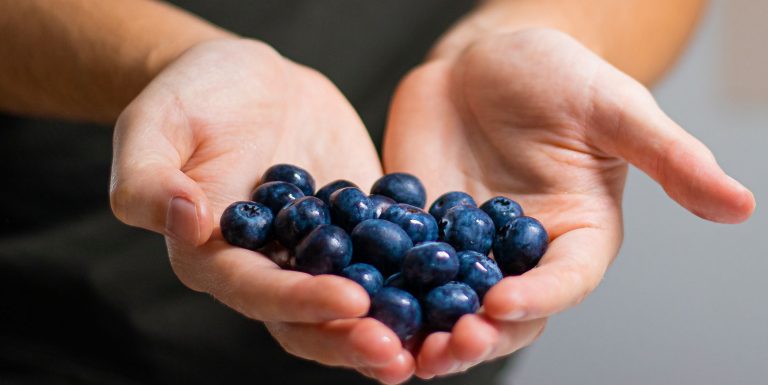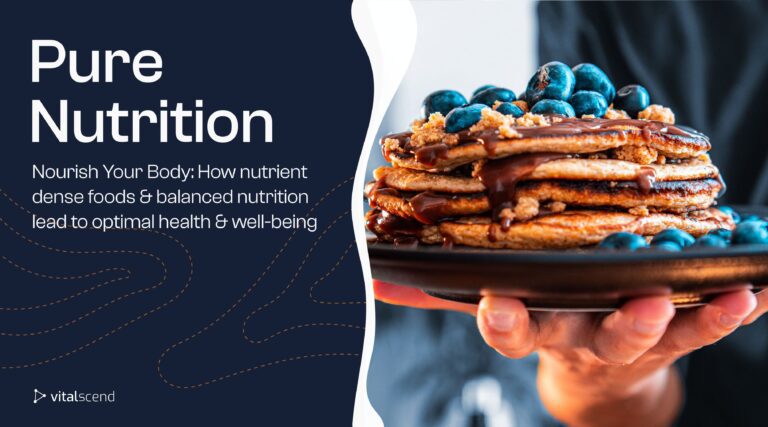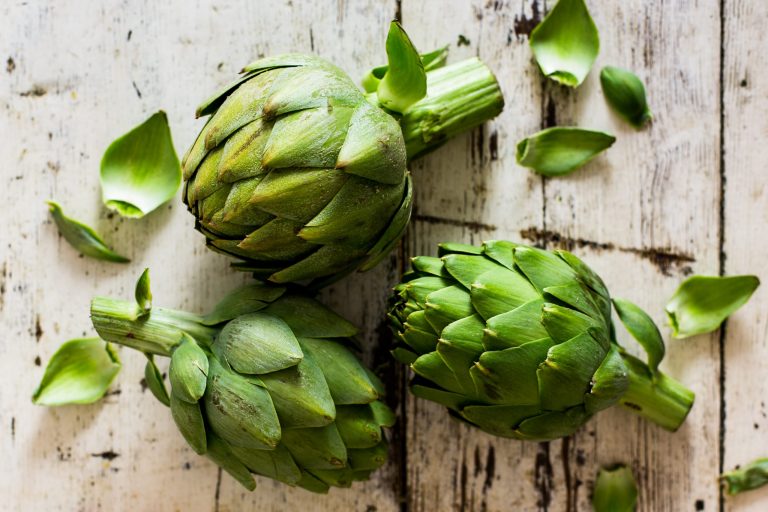Keto-Diet 101: Macronutrients, Foods, Supplements, Meal Plan & Side Effects + Ketosis Biohacks
The ultimate keto-diet 101 guide for beginners. Everything you want to know from Macronutrient profile on Keto diet to healthy Keto foods and supplements. How to prevent the Keto flu, brain fog, and other potential negative side effects are all covered in this article.
If interest in the Potential Benefits and Specific Effects of Keto Diet on the Body arise, feel free to check that out too.
What is Ketogenic Diet?
The ketogenic diet is a high-fat, moderate-protein, and low-carbohydrate diet. One of the most popular diets out there, for accelerating fat-loss, enhancing physical endurance, brain performance, mental alertness, and promoting neuroprotection.
The Keto diet has been promoted by many:
- Doctors due to its potential effects in reducing cholesterol, insulin resistance, and PCOS treatment
- Athletes as a great energy source for sustaining longer-lasting activities, such as marathons, mainly improving endurance because the body can tap into fats for fuel (not suitable for explosive sports)
- Biohackers, due to their Neuroprotective, Alertness promoting, and cognition-improvement properties
- Nutritionists, because of its potential to alter glucose metabolism, reset appetite, cut sugar cravings, increase satiety, burn fat, and control blood sugar levels.
Many diets, including Ketogenic, have controversial studies in many areas and that’s why it is important to look up a dieting option, with greater focus and attention to detail.
For example, improving athletic performance is mainly seen in endurance athletes, such as marathon runners, swimmers, and cyclists, and definitely not in weightlifters, sprinters, or team sport players.
Disclaimer: Always consult with your doctor, and do research on your own before starting this / or any kind of diet, since the Keto diet is definitely not for everyone.
Keto-Diet 101: Brief History & Origin
The Keto diet dates back to the 1920s, developed to treat pediatric epilepsy. The classic version of the Keto diet has a ratio of 4:1 of fat to carbohydrate and protein. This means excluding all starch, fruits, high-carb veggies, bread, pasta, and cookies.
In 1921, Rollin Turner Woodyatt, when reviewing diet and diabetes research found out that three water-soluble compounds which we now know as ketone bodies were produced in the liver of healthy people when they cut sugars off their diet.
So the term “ketogenic diet” was formed at Mayo Clinic, by Dr. Russell Morse Wilder, created as a diet that can produce high levels of ketones or ketone bodies in the blood. The keto diet has shown potential effects on lipid metabolism, brain function, and controlling sugar levels, hence why it gained popularity in 20th century.
Macronutrient Profile of the Keto Diet
As mentioned above, Keto is a high-fat, moderate-protein, and low-carbohydrate diet.
The main goal of the Ketogenic diet is to increase the ketones in the blood and get your body in a state known as Ketosis, which will allow all the benefits and effects of the Keto diet on your body, brain, muscles, and metabolism.
The macronutrient profile of a Ketogenic diet is:
| 70% of calories | Fats – Lipids |
| 25% of calories | Protein – Amino Acids |
| 5% of calories | Carbohydrates |
This Macronutrient profile gives you a good perspective on the foods that you will eat if you consider going KETO. Yap, a lot of meat, eggs, fish, cheese, butter, oils, nuts, seeds, berries, and green leafy vegetables.
There is a specific reason for these numbers, so here is a little explanation:
- High-fat content provides all the calories you will need to keep functioning, produce ketone bodies and get into ketosis if you cut sugars.
- Low-carbohydrate content enables your body to enter a state of ketosis, which means your primal fuel will be ketones bodies, instead of glucose.
- Moderate protein intake, and not high, is because too high levels of protein (higher than 30%) can turn into glucose and stop ketosis, due to a process called gluconeogenesis (formation of glucose).
A quick Macronutrient ratio comparison between the Keto and other diets.
| High-carb, low-fat diet | 80% carbohydrate, 10%, protein 10% fat |
| Traditional diet | 15-25% protein, 20-30% fat |
| Lean-cutting diet (bodybuilders) | 20-30% carbohydrate, 40-50%, protein, 20-30% fat |
| Ketogenic diet | 5% carbohydrate, 25%, protein, 70% fat |
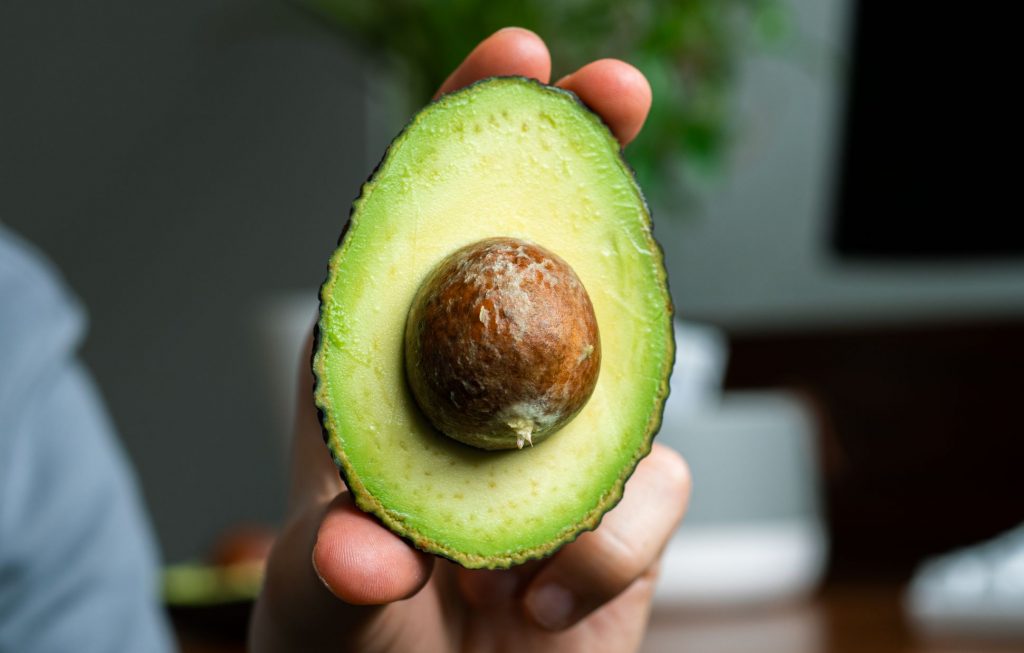
How does the Keto diet work?
To understand the underlying mechanism of the Keto diet, we need to see what is happening when you eat a lot of pancakes, pasta, and bread.
When you ingest carbohydrates, blood sugar levels rise. This triggers the pancreas to release insulin, so it can transport the sugar from your blood into your fat cells, and muscles, or store it in your liver for later usage. The cells which received glucose can use it for energy production.
For most of our body cells, the primary source of energy is glucose which comes from carbohydrates. Each of our organs, tissues, and muscles are mainly using glucose for energy. Glucose energy can be stored in the muscles, or the liver as glycogen, which is a multibranched polysaccharide of glucose that can be used for energy later on.
what happens when we don’t have enough sugar in our blood?
We hit the reset button. Our bodies go into a sugar-starvation mode. This is also the premise on which intermittent fasting can be beneficial and enable the body to reset and restore.
When we go into sugar starvation, but we fuel up on fats, there is nothing other than fats to be used as the main energy fuel. And in the Keto diet, this ratio is 70% fats, 25% protein, and 5% carbs.
Since glycogen just ran out, we have no sugars, the liver starts breaking down our fat to produce ketone bodies which become the only fuel the body is capable of at that time. This is known as Ketosis, ladies, and gentleman.
State of Ketosis
Now, why would you like to get into Ketosis, or use ketones for energy? Well, there is some evidence supporting that besides resetting your appetite and sugar craving, ketones can improve your cognitive function, mental clarity & alertness and protect your brain.
Ketosis is a metabolic state in which the levels of ketone bodies or ketones are raised. This is a natural response of the body when no glucose is supplied for a longer period.
Pro Tip
How do you know you are in a state of ketosis? Well, testing your blood or urine for ketone levels is one way, for which you need a blood testing meter. If ketone levels are above 0.5 mmol/L, you achieved a Ketogenic state.
The most popular use of the ketogenic diet is promoting weight loss since you burn a lot more fat because there is no glucose.
Dave Asprey, known as the father of biohacking had a successful weight loss and brain improvement story from the keto diet. It lead him to create Bulletproof coffee, which is created to put you in ketosis faster, due to its MCTs or medium-chain triglycerides. It is a coffee powder with grass-fed butter, MCT oil, and water, with no added sugar.
- Inducing a state of ketosis has become popular in the fitness industry due to its fat-burning effect. In fact, Keto may help you lose belly fat since many of the genes responsible for visceral or belly fat are associated with high carbohydrate & sugar consumption. (1)
- In one study on military personnel, in a state of ketosis, they lost 43.7% of visceral fat and improved 48% in insulin sensitivity. (2)
Shredding belly fat is not just for a sexy-looking physique, but a lot more. Visceral belly fat is a metabolic active tissue around your intestines that can release free fatty acids and inflammatory cytokines. Getting rid of it can significantly improve health.
The main goal of ketosis, besides improving brain function, is that it can accelerate your weight loss. The best part is, the state of ketosis is known to make your body the fat-burning machine.
Is keto diet good for the brain?
Although acutely reducing glucose may reduce brain performance, after adapting to keto people experience mental alertness, focus and better memory. Partially, this is due to the mechanism of using fats for to fuel the brain tasks. Keto-fueled brains are better at converting excess glutamate to glutamine, which helps with brain function, focus, prevents hyperexcitation and reduces stress.
What foods can be eaten on the ketogenic diet?
Although acutely reducing glucose may reduce brain performance, after adapting to keto people experience mental alertness, focus and better memory. Partially, this is due to the mechanism of using fats for to fuel the brain tasks. Keto-fueled brains are better at converting excess glutamate to glutamine, which helps with brain function, focus, prevents hyperexcitation and reduces stress.
What foods to avoid on the keto diet?
There are two categories of foods you would want to avoid during a keto diet, and these are high carb foods (sweets, fruits, juices, pasta, rice) and unhealthy fatty foods (bacon, ham, salami, sausage, mayo, butter).
Ketone Bodies
Ketone bodies are water-soluble molecules or chemicals produced by the liver from fatty acids, when sugar content is too low, which is present in carbohydrate restriction diets or fasting.
Ketones are produced in the state of ketosis, acting as the major energy fuel for the cells and organs in your body. They are a by-product of your body’s fat-burning mechanism.
There are three main ketone bodies:
- Acetone
- Acetoacetate
- Beta-hydroxybutyrate
Most of the foods presented in a healthy and efficient keto diet are rich in MCTs because they can be converted into ketones faster and easier. MCT oil is one of the richest sources of MCTs which can accelerate fat-burning and get you into ketosis faster.
Most of the foods on the Keto diet should be rich in MCTs so you have a better effect on fat-burning and brain enhancement. MCTs stand for Medium-chain triglycerides and are more ketogenic than LCTs, which are long-chain triglycerides.
MCT oil is known as one of the best supplements for Keto practitioners since it can speed up the process.

Ketones vs Glucose
I’ve stumbled upon many phrases such as “keto brain”, “ketogenic alertness” and “keto mental clarity”. Are keto brains functioning better, healthier, and are less inflamed or less prone to neurodegeneration?
First of all, we must agree that the primal source of energy for the brain is glucose. (3) The brain takes up about 120 grams of glucose daily. Much of this energy (60-70%) is used for power transport mechanisms involving sodium and potassium nerve impulse transmission, plus synthesizing neurotransmitters.
In starvation mode, whether it’s sugar starvation, calorie restriction, or intermittent fasting, the brain uses ketones to replace glucose, as brain fuel.
When one eats ketogenic, the brain can produce more energy per unit of oxygen, since fats store more energy than carbohydrates. Brains utilize more ketones in ketogenic diets. (4)
Keto-Powered vs Glucose-Powered Brain
Keto Brain
Glucose Brain
Several studies support the evidence that a Ketone-fueled brain:
- Has improved cognitive function (5)
- Better mental performance, clarity, and alertness (6)
- Better neuroprotective capacity may prevent neurodegeneration (7)
- Is more energy efficient (BHB provides more energy per unit oxygen used) (8)
- May be more efficient in learning and memory (due to improved mitochondrial function in the hippocampus) (9)
- Has more potent antioxidant, and anti-inflammatory activity (10) (11)
However, glucose is not our brain’s main energy source by accident.
Glucose is not detrimental to our health or brain at all if we use the right type of sugar in moderation. Understanding this will enable you to see that both glucose and ketones can be a great source of energy for your brain.
Glucose powered brain has these characteristics:
So, as long as we do some fasting or keto to reset our appetite, and sugar cravings and reduce inflammation, we are fine running on glucose powered brain.
Fun Fact
There is some evidence supporting that carbohydrate-enriched liquid, can improve sports performance in endurance athletes. Now the fun thing is, they did not drink the liquid, but just did a mouth rinse. This is thought to promote a good-feeling sensation and activate the dopamine reward centers in the brain which gives an impression of less physical stress. Drinking the liquid may hinder the fat-oxidation in the later stages of marathoners’ run, so rinsing is a good way to cheat the brain.
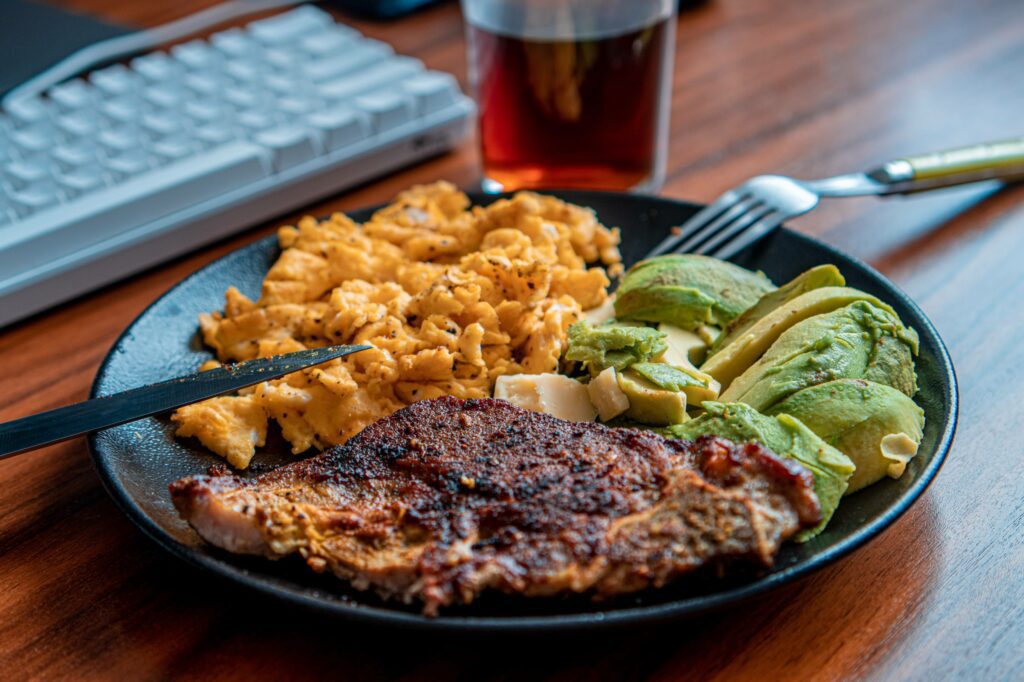
What to eat on the Keto diet
Ketogenic diet will work its magic whether you eat healthy or unhealthy, but there is a price to pay. Your health will suffer if you eat overly processed unhealthy high-fat foods, even if you are still losing weight.
When it comes to weight loss, calories in vs calories out is the only math, but when it comes to your health, the food is not just calories. It is either nutrient-dense providing a lot of vitamins, minerals, fatty acids, antioxidants, etc. or it is high-calorie nutrient-poor food.
Since you choose to eat a lot of fats, you better be on healthier foods, since they can promote satiety and make you feel full, while providing you with the nutrients you need. Also, leaning towards more nutrient-dense foods is important as on keto, you eat less volume. Why? Because 1 gram of fat is 9 kcal, while 1 g of carbs is 4 kcal.
Most of the participants in the following have been eating what’s considered a “healthy keto diet”. This is crucial because some of the benefits of a Ketogenic diet in blood sugar & pressure regulation, performance improvement, and reduced inflammation come from these healthy foods, meaning you shouldn’t expect to eat bacon all day and have your cholesterol numbers looking just fine.
Keto Foods to Eat
Here is the list of the healthiest foods you can eat on a Ketogenic diet
Avocado
One of the best options for Keto practitioners. It is a high-fat fruit, loaded with essential minerals and vitamins. Being high in Omega 3’s it possesses anti-inflammatory properties and it has a pretty high amount of potassium, which is important for nerve signaling, fluid balance, and muscle contractions.
Eggs
Eggs are a great alternative since they provide the body with tons of essential nutrients. Eggs are high in iron, B vitamins, carotenoids, and saturated fats, plus they contain selenium, vitamin D, B6, B12, and zinc, which are all pretty important in muscular development. There are also two powerful antioxidants: lutein and zeaxanthin present in eggs, which fight against inflammation.
Coconut Oil
One of the best oil options for the keto diet. Coconut oil is one of the go-to when it comes to a ketogenic diet, mostly due to its nutritional profile. This oil contains MCTs which can make you transition into ketosis faster, accelerate fat loss, and improve cognitive function. Plus coconut oil has been used in preventing neurodegenerative diseases and reducing inflammation.
Cottage Cheese & Greek Yogurt
Both are great substitutes for regular, sugar-processed yogurt or other cheese types, being some of the leanest dairy products on the market, containing up to 18 grams of protein per 5 ounces. Loaded with high-quality protein it is a great source of the important amino acid Leucine, you should keep both of these in your fridge.
Nuts
Nuts are a high-fiber, high-fat, high-protein option, which works great on Keto. The ratio of fiber vs carbohydrates is pretty impressive, making this food a great addition to a keto dessert or snack. Some of the leanest options of nuts (by lean I mean low carb) are almonds, walnuts, macadamia nuts, brazil nuts, pistachios, and cashews.
Wild-caught Salmon
If we are talking about lean protein, full of vitamins and minerals, salmon is definitely making it into the top five list. Salmon is a great source of omega 3’s, B12, choline, and selenium. These vitamins provide a great benefit for the brain, in terms of cognition, memory, and neuroplasticity.
Grass-fed Beef
If the beef is grass-fed, overall it is healthier. It is loaded with nutrients, especially fatty acids. Grass-fed beef contains CLA which is conjugated linoleic acid that is great for improving immunity and fighting inflammation. Plus CLA can help with muscle preservation and maintaining weight loss.
Mushrooms
Edible mushrooms are a great keto option since they are low-carb high protein veggies. Mushrooms are a great addition to any fatty sauce, meat, or salad meal, and even creamy mushroom soup. Rich in B vitamins and selenium, this food can support the immune system and muscular development. Some great options include Portobello, Shiitake, Chanterelle, and Champignons.
Seeds
Seeds are also low-carb, high-fat food, most of which are loaded with healthy fats and fiber, just like nuts. Loaded with omega 3, manganese, and magnesium, seeds are a great addition to any meal you cook. They are good for the brain, healthy food for the heart, and can improve digestion. Some of the healthiest varieties out there are chia seeds, flax seeds, sunflower seeds, sesame seeds, pumpkin seeds, and hemp seeds.
Grass-fed Butter
If you are doing Keto, you have probably heard of this. When it comes to fats, besides olive and coconut oil grass-fed butter is the best alternative. It is an antioxidant powerhouse, rich in vitamin A and beta carotene which is great for healthy skin and vision. Plus it is high in CLA and vitamin K2, which provide additional benefits for weight loss and bone health.
Cruciferous vegetables
Vegetables like broccoli, cauliflower, cabbage, and Brussels sprouts are great, lean alternatives for the Ketogenic diet. These veggies are also rich in many important vitamins and minerals such as folate, vitamin K, vitamin C, calcium, potassium, and manganese which have many health benefits.
Dark Green Leafy Vegetables
As a great source of fiber, while being a low-carb option, leafy veggies such as spinach, kale, collard green, Swiss chard, romaine lettuce, arugula, and bok choy make it on the Keto list. These veggies are loaded with folate, carotenoids, vitamin C, and vitamin K, plus are a great source of antioxidants.
Berries
When it comes to fruits, the list is short here. Avocado, berries, coconut, cantaloupe, watermelon, olives, and citrus fruits can make it on the list. Blueberries, raspberries, and blackberries are great fruits suitable for the ketogenic diet, loaded with tones of antioxidants that exert an anti-inflammatory effect.
Cocoa, Tea, and Coffee
Only the unsweetened version of those beverages can be enjoyed on a true ketogenic diet. Adding stevia, cinnamon or erythritol can make the coffee taste better, and sweeter without considerable addition of sugar. There is caffeine in each of these beverages or powders, which can increase energy levels and mental alertness. Adding some fats to it, such as MCTs or organic ghee, or grass-fed butter, can even further improve the effects of ketosis, and transition you faster in it.
Chicken
One of the leanest proteins you will ever get is chicken. Now considering you already have a high-fat profile of avocados, cocoa, grass-fed butter, olive oil, and salmon, the addition of chicken is great due to its nutritional profile. Chicken contains many important B vitamins, supporting the nervous system, muscular development, and skin health, plus it is loaded with calcium and phosphorus which provide additional benefits for your bones.
Turkey
If you remove its skin, turkey is one of the leanest meat out there. Dark turkey can be more suitable for the Keto diet in comparison to white since it contains more fats, vitamins, minerals, and calories. Per 100 grams of roasted turkey breast, you get around 160 kcal, 30 grams of protein, almost 4 grams of fat, and no carbs.
Healthy Oils
Switching your oils in the kitchen will give you a great boost in health, due to some anti-inflammatory properties and vitamins that healthy oils contain. Aim for virgin coconut or extra virgin olive oil as the best option, great alternatives are also macadamia nut oil, avocado oil, walnut oil, grass-fed ghee and butter, flaxseed oil, and beef tallow.
Blue Cheese
When it comes to cheese, it is the ultimate high-fat, high-protein, low-carb addition to any salad, lunch, dinner, or salty snack option. Cheese contains vitamin B12, protein, and calcium which are crucial for muscular and skeletal development, plus it is rich in casein, the slowly digestible protein. Great alternatives are also cheddar, parmesan, goat cheese, mozzarella, ricotta, and Swiss cheese. Do not over-consume it, due to potential sodium overload, which may raise blood pressure.
Keto Foods to Avoid
When it comes to what foods you should avoid on the keto diet, there are two categories:
High-carbohydrate foods that are not suitable for Ketogenic Diet:
| High Carb fruits | banana, raisins, pineapple, mango, apple, grapes, pear, and kiwi |
| High Carb veggies | sweet potato, tomato, leek, artichokes, turnips, okra, potato, corn, onion, carrots, squash, green peas. |
| Refined sugars | donuts, cookies, chocolate, croissant, candy, sweets |
| Energy drinks & Sodas: | Colas, Sodas, Cocktails, Sugar-rich coffee, Iced tea or fruit juice with additives, fruit smoothie, soft dunks, and sports drinks |
| Whole grains | Barley, Buckwheat, Black rice, Corn, Wheat, Rye |
| Refined grains | white bread, cereal, white pasta, white rice |
| Fast food | burgers, pizzas, pasta, French fries, hotdogs, tortillas |
Keep in mind that I did not list some foods such as quinoa, whole-wheat pasta, oats, beetroots, chickpeas, and kidney beans, which in turn are high in carbohydrates, but since they provide such great nutritional content, I would eat some of them every time I’m breaking my Ketosis since they are a great source of fibers, vitamins, minerals or antioxidants.
High-fat foods suitable for a Ketogenic diet, but NOT healthy
| Unhealthy oils | canola, soybean, vegetable, peanut, sunflower, margarine |
| Processed Meat | bacon (sorry), salami, corned beef, deli meat, ham, catfish, duck, and chicken nuggets |
| Salad dressings | balsamic vinaigrette, creamy Caesar, country French, green goddess, and honey mustard |
Many salad dressings won’t be suitable for Keto due to sugar content, in either way, I wanted to put it out because a lot of people overlook the little things they put in their meals which can be detrimental to their health or take them out of ketosis. I mean come on, who measures the weight of that salad dressings and counts his macros, right?

Potential Benefits of Keto Diet
In this section, I will explain the potential benefits of a ketogenic diet briefly. If you are interested in more of an in-depth scientific article on specific effects of a ketogenic diet on brain function, fat-loss and anti-aging you can check this article.
Keto Comparison & Benefits
If you are curious about which diet is for you, high-fat low-carb, or high-carb low-fat, you should first see the pros and cons of both of them. Choosing a diet is not easy, especially not with this much information in hand.
But in a couple of steps, we’ll make it easier for you. Keep in mind that genetics also play a huge role here, so this will not fit everyone, but is rather a more general approach. Goals are very important as well
Both high-carb and keto diets can work for weight loss if your caloric intake is lower than the calories you burn. But both diets work on different energy mechanisms and can have different effects on the body, so here is a quick comparison.
Keto diet Benefits
The ketogenic diet has many proven benefits and mechanisms of action. Mainly, high-fat diets with carbohydrate restriction such as keto, or Atkins, work in the body by inducing a state of ketosis. (16) (17)
Since the level of ketones is raised in the blood, there are several effects on the body:
- Increased fat oxidation (leads to rapid weight loss)
- Improved insulin sensitivity (because levels of glucose are low)
- Reduced insulin resistance (again because blood glucose is decreased)
- Improved cholesterol profile (reduced LDL, triglycerides, increased HDL)
- Anti-inflammatory effects
However, it is important to note that the Ketogenic diet will initially reduce physical energy and improve mental energy, stress resilience, and alertness. For some, this might be a great while for others, not so much. Let’s check a simple comparison, who’s Keto diet more suitable for?
- 18 years-old student, who has two workouts a day x 45 minutes, a professional athlete with a body fat of 12% I the latest stages of growth
- 58-year-old lady with insulin resistance, overweight, who works at the office as an architect and suffers from chronic stress and inflammation
Probably, the 58-year-old overweight lady will benefit a lot more than the growing teen athlete from the keto diet, so who you and what’s your goal is very important.
Now it is true that Keto can cause inflammation or an acidic state, but the relation between heart diseases and weight gain to keto may not be true, because even obese & insulin resistant people have reversed insulin resistance on the keto diet (18) and diabetics can reduce or get off the medications because of this diet. (19)
High carbohydrate diet
Carbohydrate diets are dominant and most people around the world eat above 50% of their calories as carbohydrates.
A high-carbohydrate diet may affect thyroid function which influences your total energy levels & metabolism. (20) Besides this, carbs are the best fuel for athletes, especially those competing in explosive, speed, strength, and team sports. (21)
- May balance thyroid function
- Increase energy (due to improved thyroid function)
- Speed up the metabolism (due to improved thyroid function)
- Balance Cortisol Levels (22)
- Improve mood (sugar activates dopamine reward centers in the brain)
- Improves physical performance (glycogen replenishment)
As you may know, almost all athletes besides the ones competing in endurance sports, eat a high-carbohydrate diet.
Endurance athletes also usually consume high carbohydrate and high-calorie diets, but there is evidence that the Keto diet completely changed their exercise performance, mainly due to improved energy production and metabolic efficiency – fats have more in comparison to carbohydrate glycogen per oxygen unit.
But this is mainly in sports with lower intensity and longer duration. Usually, in any other strength or speed sports, carbohydrates are the main fuel. After a hard workout, a great regeneration for the muscle is a combination of carbs and protein, to replenish the glycogen levels and provide amino-acid for muscle growth.
So if you are an active, athlete, low-body fat, fast metabolism, or overly stressed type of person, a carbohydrate high diet is potentially your favorite one.
Conclusion
The Keto diet is more suitable for faster weight loss, especially fat loss due to the fat-oxidation, plus the ketone bodies can feed your brain and improve cognition, mental performance, and alertness. A high carbohydrate diet is suitable for most people, it has the potential to improve exercise performance, speed up metabolism, increase energy levels, balance cortisol levels, and improve mood.
Keto vs Atkins vs Paleo Diet
Although the Keto diet is similar to Atkins and Paleo diets, it is not the same.
- Atkins diet is a four-phase diet that starts with the same Macronutrient profile as the Keto diet but slowly increases the carbohydrate intake.
- Keto diet is the harder version, phase 1 of the Atkins diet which mainly forces your body to work in a state of ketosis, while the Atkins diet throws you off of ketosis soon, but it is more sustainable and easier to stick to.
- Atkins diet increases carbohydrate intake over time, but it is still considered a low carb diet since the 4th and final phase allows around 100 grams of net carbs. Atkins was a lot more popular before the ketogenic one arose, but it is still used quite a lot for weight maintenance because it is easier to attain.
- Paleo diet, however, can be a Keto diet but does not necessarily have to. If a Paleo eater decides to remove starch and carbs from the diet and sticks to high-fat low carb options, it can be a Paleo-Keto dietitian.
Paleo is the diet of our primal ancestors which have been mainly feeding on:
| Low-carbohydrate fruits | raspberries, blackberries, strawberries |
| Meats | chicken, turkey, fish, bison |
| Vegetables | turnips, carrots, spinach, broccoli, avocado |
| Nuts and seeds | almonds, walnuts, cashews, flax seeds, chia seeds |
This diet is considered to be from Paleolithic times, also referred to as the Paleo diet. Paleo diet eaters can have plants, nuts, seeds, meats, fish, eggs, vegetables, and fruits. The Paleo diet is not necessarily a Ketogenic one but can be, since Paleo does not restrict Macronutrient profile, but food options.

Negative side effects of the Keto Diet
As there are many benefits from the Keto diet, there are also some potentially negative side effects.
Now, in each person this is different and it depends a lot on the type of foods you eat, your genetics, metabolism, hormonal balance, stress resilience, age, sex, etc.
- Adaptation Phase
- The Keto Flu
- Yo-Yo Effect
The Adaptation Phase
It is important to know that there is an adaptation phase on a low-carb diet. At first, a keto diet will affect your energy levels and metabolism. Usually, people feel less energized, more tired, and fatigued, falling down along with their sex drive.
People experience irritability, weakness, fatigue, headaches, and even nausea, vomiting, and constipation. Some of which are side effects of dehydration. Some other side effects due to losing your main fuel – carbohydrates are dizziness, inability to focus, loss of concentration, stomach cramps, low libido, and so on.
Once the adaptation phase is over, one gets to feel the benefits of the ketogenic diet. Mental performance improves, your brain is working faster and sharper, you lose fat faster and feel better.
The Keto diet is carb restrictive and a fast transition can always lead to the yoyo effect. The Yo-yo effect is the opposite effect on your body, so if you have restricted your calories and did not keep up with it, after some period your body will want all of this fat back, and even more. Think why “the biggest loser” show or “I’ve lost 50lbs in 1 month” is not a healthy and sustainable weight loss goal.
Long-term effects of the Keto diet
As mentioned above, the Keto diet might not be safe in the long term.
In my opinion, the Keto diet is a great reset diet that the majority can benefit from, in weight loss, brain function, and inflammation. However, I wouldn’t go longer than 3 months on Keto because of the potential side effects.
| Ketoacidosis | when the body produces too many ketones in the blood, which happens during keto dieting, the blood becomes too acidic and may cause damage to the kidneys, brain, and liver. |
| Decrease in Exercise Performance | following a ketogenic diet for longer periods as an athlete can be hard since most athletes use glycogen as the main energy fuel. It has been shown that endurance athletes have benefited from Keto, but for team or strength sports, it is not recommended during competition. |
| Yo-yo effect | Reducing the carb intake so drastically can enable the body to turn on its fat-saving mechanism and crave carbs even more, which usually results in weight regain after quitting the diet. |
| Slower Metabolism | The Keto diet provides a lot of fats and moderate protein, while carbohydrates are cut off. Carbohydrates can increase your metabolic rate, and energy levels, and maintain cortisol balance. Long-term Keto may slow down the metabolism and reduce levels of T3, the thyroid hormone. |
| Cardiovascular disease | For people who take the unhealthy part of the ketogenic diet, just because it is fancy and you can eat anything that’s fatty, they should reconsider their diet. Eating a bunch of processed meat and unhealthy oils is not good for your heart health, nor your vessels, or cholesterol levels. |
| Loss of muscle mass | The Keto diet leads to weight loss, but some of this weight loss can be muscle loss. If you are eating lean meat, fish, nuts, eggs, and green veggies, this shouldn’t be of concern. However, the keto diet provides a moderate, not high amount of protein, so be aware of that. |
| Mood swings | Because carbohydrates can control cortisol levels, when one cuts sugars off of his diet, he doesn’t just feel tired, but also a bit fuzzy. The ability to respond to stress is hindered in one who craves sugars because sugar activates dopamine reward centers in the brain. |
In terms of health through the perspective of nutrients, the Keto diet can be a healthy diet if you consume the right foods in the right amounts. Adding a good amount of healthy fats to your body can help with hormone production, cardiovascular health, weight loss & fat loss, reducing inflammation, and fat-soluble vitamin absorption.
Make sure to stay away from unhealthy oils and processed meats and instead fill up on green leafy vegetables, low-carb fruits, grass-fed meat & butter, healthy oils, and some nuts and seeds.
There is some risk associated with every diet. The Keto diet is not dangerous or unstudied, but still the effects depend a lot on the individual. There is a major difference between an unhealthy and healthy ketogenic diet – following a healthy structured plan by a nutritionist, doing blood checks, being supervised by a doctor, supplementing correctly, etc.
Is Keto Diet Healthy/Safe?
The answer to this question is both yes and no. It really depends on the consumer.
A ketogenic diet may help with insulin resistance, stabilizing blood pressure and sugar levels, mental alertness, brain function, and weight loss.
In my opinion, Keto is one of the best Reset diets, in terms of glucose and lipid metabolism, refreshing your whole body, brain, and muscle. However, I personally would not recommend anyone to stay on a Keto diet longer than 6 months, since the long-term effects are not studied as well and might cause some serious side effects. And yep, we are talking about strict, continual Keto diet.
Potential Risks of Ketogenic Diet?
Some potential risks of a Ketogenic diet are:
- loss of bone mineral density
- irregular menstrual cycles
- insomnia and disturbed sleep
- dehydration and loss of electrolytes
- acute kidney injury
- cardiac arrhythmia
- Acidity
Who should avoid Keto Diet?
Keto diet may have some negative side effects in these groups, or people with the following conditions:
- Breastfeeding or pregnant women
- Children in the phase of growth
- Kidney disease
- Metabolic syndrome
- Gallbladder disease
- Pancreas insufficiency
- Hypoglycemia
- Liver diseases
- Eating disorder
- Muscular dystrophy
- Mental problems
- Gastric bypass
- Chronic inflammation
It is best to consult with your doctor and nutritionist before attempting any new diet, including Keto, to avoid possible negative side effects

Keto Supplementation Basics
Choosing a carb-restrictive diet may interact with a nutrient deficiency if it is not followed correctly.
A ketogenic diet in its structure is not micronutrient deficient, which means it doesn’t lack the needed vitamins and minerals, but if you choose high-fat foods with poor nutrients then you might as well be deficient in certain nutrients.
Keto eaters tend to be deficient in certain minerals, due to loss of electrolytes through dehydration and this is how keto flu starts to exert its effects. Being nutrient deficient is not good for your health at all, since you don’t have the needed nutrients to support healthy physiological function.
Common Deficiency on a Keto Diet
| Minerals & Electrolytes | Magnesium, Sodium, Potassium, Calcium, and Phosphate |
| B Vitamins | especially B9 (folate) and B7 (biotin |
| Fat-Soluble Vitamins | Vitamin A, E and D |
| Essential nutrient | Choline |
Before you jump up to buy some supplements, first let’s discuss food. Supplements can work great too, but first, you must check on your nutrition and make sure you are getting a large variety of foods to improve your micronutrient content.
Best Keto-friendly Foods to fulfill your micronutrient deficiencies:
| Minerals and electrolyte | great Keto options are mushrooms, sardines, broccoli, kale, spinach, oysters, avocado, Swiss chard, pumpkin seeds, almonds, and cheddar cheese. |
| B-vitamin rich foods | turkey, eggs, green leafy vegetables like spinach, romaine lettuce, turnip greens and collard greens, salmon, sunflower seeds, eggs, organ meats, grass-fed beef, oysters, and chicken |
| Vitamins A, D, and E | Cod liver oil, egg yolks, caviar, feta cheese, salmon, mushrooms, sardines, canned tuna, beef liver, goat cheese, hazelnut oil, almonds oil, brazil nuts, avocado, pine nuts, and abalone |
| Choline rich foods | Eggs, egg yolk, red meat, broccoli, liver, green peas, salmon, beef, shrimp, chicken |
Once you restructure your diet to a healthier vitamin and mineral content, you might as well consider powering up your keto diet with some supplements. A very important thing to take into consideration when supplementing on a Keto diet is what is your main goal.
There are two main categories when it comes to Keto supplements, the ones that can improve the effects of ketosis (fat-burning, anti-aging, brain function) and the ones that you supplement to ensure a proper micronutrient profile (vitamins, minerals, antioxidants).
Your initial goal for supplementation will determine what you may supplement with so, I listed the top Keto supplements for specific goals and effects in a Keto eater.
Here is a list of the most important Keto-supplements:
- Electrolyte Powder for Mineral Replenishment
- MCT Oil to Accelerate Fat Loss and get into Ketosis Faster
- Brain Octaine Oil C8, supports brain function and provides fuel
- Digestive Enzymes to Improve Lipid Digestion
- Exogenous Ketones, to get into Ketosis quicker and more efficient
- B-Complex, to support energy production and Fat breakdown
- Omega 3’s, fish oil to reduce Inflammation
- Choline, an essential nutrient that supports brain function
Conclusion
The Keto diet is a 70% fat, 25% protein, and 5% carbohydrate diet that can accelerate fat loss, improve brain function, and reduce inflammation. It works by putting your body in a state of ketosis in which you burn fat for energy and ketones provide your body and brain with energy. It works great for mental alertness, endurance training, fat oxidation, and weight loss. The ketogenic diet may be associated with some side effects, like nausea, keto flu, or brain fog, so consulting your doctor and nutritionist before attempting it, is a great idea. Supplements like B-complex, Electrolytes, Folate, Choline, MCTs, Omega 3’s, Digestive enzymes, and Exogenous Ketones can improve the effects of the Keto diet and put you in a state of ketosis faster.
Frequently Asked Questions
What are the potential benefits of a keto diet?
Some potential benefits of the keto diet are:
1. May promote weight loss and accelerate fat-loss
2. may improve brain performance & cognitive function
3. May support the cardiovascular system & lower cholesterol
4. May reduce inflammation
5. Could Promote a Healthy, Glowing and Youthful Skin
What is the keto diet?
The keto diet, also called a ketogenic diet is a high-fat, moderate protein and low-carbohydrate diet. The macronutrient ratio is: 70% of Fats, 25% of Proteins and 5% of Carbohydrates. The idea is that our body can reap many benefits from starting to use fats as the main fuel source over glucose.
How do I adapt to the keto diet?
Going straight on a ketogenic diet may cause some unwanted effects like fatigue, energy loss, mental performance decrease, keto flu etc. These are all part of the adaptation phase, including nausea, constipation and irritability. This is why, it is better to slowly reduce the intake of carbohydrates and increase the intake of fats, so the transition is not as fast and shocking to the body (which acutely increases inflammation). You can consider the Paleo or Atkins diet first, before attempting Keto, for easier transition.
What is the Keto flu?
Keto flu is a side-effect of quick transition from high-carb to low-carb and high-fat diet. Some side-effects of the keto flu that keto-eaters experience include: irritability, energy loss, fatigue, constipation, nausea, dehydration, headaches, low libido and so on.



